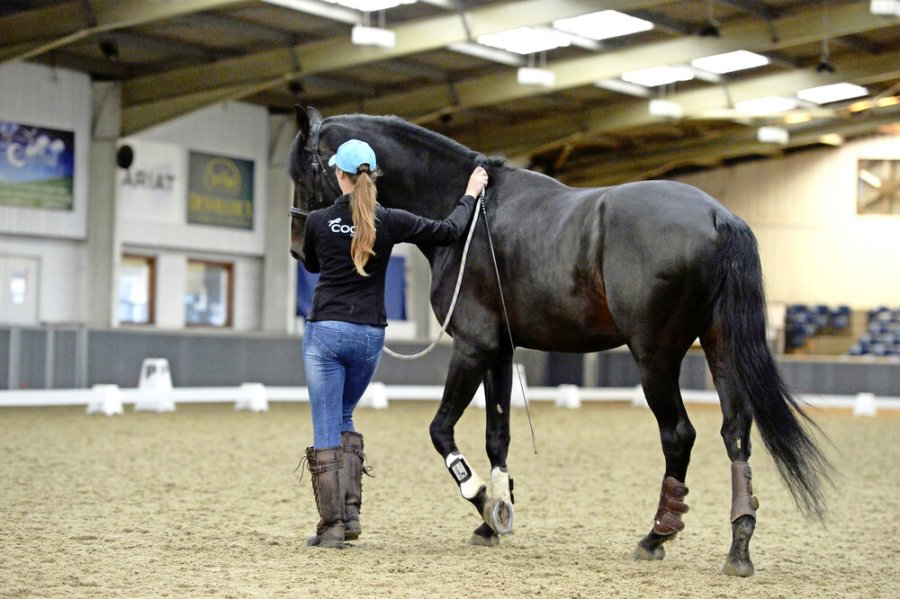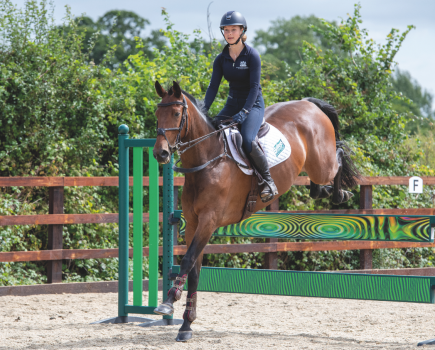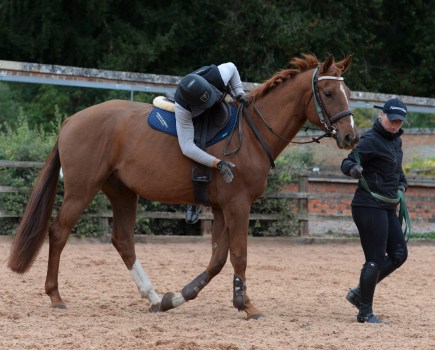Groundwork will challenge your horse mentally and physically, as well as encouraging them to relax and focus on you. These exercises from Paralympic dressage rider Bert Sheffield will teach you to use your body language as a form of communication with your horse.
These two exercises – leading and backing up – are the foundations of everything. They teach your horse how to keep connected with you at a nice distance. They’ll learn better spatial awareness and to take responsibility for their position relative to you. You will learn how to use peripheral vision and your mental energy more.
I find that some people get slightly worried about this new way of leading more remotely and when they feel they’re in a challenging situation they want to go back to leading their horse more closely again. However, I’ve used this method when handling breeding stallions, rearers and general horsey thugs in many difficult situations – and trust me, you’re safer when your horse is at a respectfully agreed distance.
Getting started
You will need a rope halter and a fairly long rope – something about 14ft long and made of yachting yarn is ideal. If you don’t have a rope halter you can use a lunge cavesson (then the rope will attach to the centre ring on the nose). I don’t recommend a thick fluffy headcollar and a lunge line or a normal leadrope as they don’t give you the same feel.
Booting up
I like to put boots on my horse’s legs for this work – you’re asking them to cross their legs and they could potentially knock into themselves. I often do this work before I ride, so having a saddle on is fine.
Your equipment
You need to wear your normal protective equipment – an up-to-standard hat, strong boots and gloves to protect you from rope burns if things go wrong.
Control your emotions
The aim is to educate your horse, not to punish them, so keep your requests emotionless and below a level at which they might feel the need to brace against. You want to always be looking to stop asking when your horse is thinking of complying, rather than to keep on asking until they’ve completed the request. Your horse doesn’t know what you want, so play a game of ‘hot, cooler, warmer, cold’ with them.
Exercise 1: Leading
Stand still and set up your rope. The idea is that your horse has half the 14ft rope length and you have the other. As I expect the rope to have a little sag in it, the ideal is that your horse is about 6ft away from you when you’re walking.
How to do it:
- Once your rope length is sorted, walk away from your horse so that they’re in the four or five o’clock position to your right shoulder. Imagine that 12 o’clock is directly in front of you, three o’clock is level with your right shoulder, and six o’clock is directly behind you.
- Now keep walking and trust that your horse maintains their distance – most will want to creep forwards.
- You have two options if this happens. First, you can stop and back your horse up to put them back into their place relative to you – you will need to follow exercise 2 for this.
- Your second option is to turn abruptly to the right, making them stop while you walk through their path, and then carry on once the position is re-established.
- If your horse has the opposite problem and is hanging back, then you can turn sharply to the left, looking over your left shoulder at their bottom as you turn to add energy and playing a little game of ‘don’t let me catch your bottom’ to make them follow you a bit faster.
- Practise the leading (increasing your speed when you’re ready) and turning, being really conscious of your horse’s position relative to you. You want to teach them to take responsibility to orientate themselves to you. Don’t worry about getting to a destination until you have got this sorted in a field or arena just wandering about.
Exercise 2: Backing up
This skill and leading work hand in hand – if you want your horse to lead nicely you need to teach them to back up easily.
How to do it:
- Start the back-up by standing in front of your horse, about 6ft away from them, holding the end of your rope. The middle of the rope should be resting on the floor between you.
- Now think about moving your horse’s feet away from you. Build up energy and intention in your mind, picture exactly what you want them to do, then move the rope in a gentle side to side motion with the rope still resting on the ground.
- Imagine bowling a ball of energy (without moving towards your horse) from your mind to the front foot that you want them to move first. Focus on that foot until they start to move their weight off it, then soften your body language and energy.
- Repeat this until your horse starts to actually step back.
- If you don’t get a weight shift reaction, move the rope slightly more vigorously so the middle comes off the ground a little, but without ragging their head from side to side. Don’t worry about straightness at this stage – that comes with understanding.
Meet the expert: Bert Sheffield, of HeartHorse Dressage, is a Canadian Paralympic dressage rider and UKCC coach, based in Lincolnshire. The pair finished 12th in the grade III individual contest on 69.77% at the 2021 Tokyo Paralympics.
Receive six issues of Your Horse magazine for just £15!









